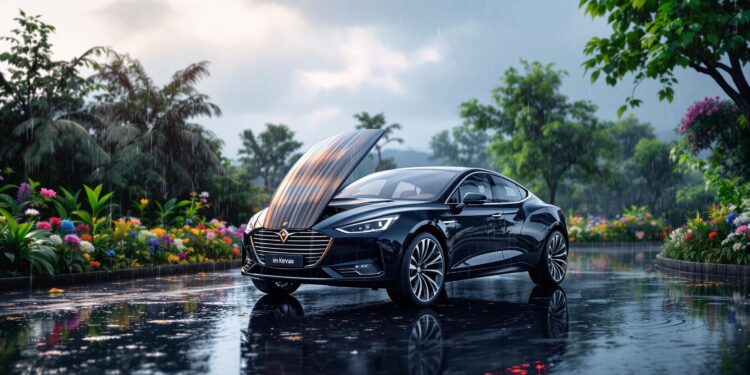Want to keep your car safe and running smoothly during Kenya’s rainy seasons? Here’s what you need to know: Wet weather increases accidents by 20%, rust issues by 50%, and water damage claims by 35%. Proper car care can reduce risks, extend your car’s lifespan, and save money on repairs.
Key Tips at a Glance:
- Tires: Ensure tread depth is at least 3mm and maintain proper pressure.
- Wipers: Replace every 6-12 months and clean monthly.
- Lights: Check all lights weekly for functionality and moisture buildup.
- Brakes: Inspect pads, discs, and fluid monthly.
- Rust Prevention: Clean and protect vulnerable areas like the undercarriage.
- Battery: Test charge monthly and keep terminals clean.
- Emergency Kit: Pack essentials like jumper cables, a reflective triangle, and a first aid kit.
How to take care of your car during the rainy season
1. Check Tire Condition
Keeping your tires in good shape is crucial for avoiding accidents in wet weather. According to the National Transport and Safety Authority (NTSA), tire-related issues caused 14% of road accidents during the rainy season in 2022.
Although Kenya’s legal minimum tread depth is 1.6mm, experts suggest aiming for at least 3mm of tread depth during rainy months. This added depth helps channel water away from the tires and lowers the risk of hydroplaning on slippery roads.
Use the simple shilling test to check your tread depth: place a 1 shilling coin into the tire grooves. If you can see the entire year engraved on the coin, it’s time to replace your tires.
Don’t forget to maintain the pressure recommended by your tire manufacturer. Check the pressure when the tires are cold for accuracy. Proper inflation can improve braking distance by up to 4 meters. Underinflated tires increase the chance of hydroplaning, while overinflated ones reduce traction.
Once your tires are ready, it’s time to focus on ensuring clear visibility – start with your windshield wipers.
2. Replace Windshield Wipers
After ensuring your tires are in good shape, it’s time to focus on visibility – especially crucial during Kenya’s heavy rains. According to the National Transport and Safety Authority (NTSA), poor visibility accounts for around 15% of road accidents during wet weather.
For better performance in harsh conditions, experts suggest flat beam-style wipers or silicone-based options. These are built to handle heavy rainfall and intense UV exposure. Top-rated brands include Bosch Icon, Rain-X Latitude, and PIAA Si-Tech silicone wipers.
Keep an eye out for these signs that your wipers need replacing:
- Streaking or skipping on the windshield
- Squeaking noises during use
- Cracked or frayed edges
- Uneven contact with the windshield
"Properly functioning windshield wipers are not a luxury, but a necessity for safe driving during Kenya’s rainy season", says John Mwangi, Head of Road Safety at the NTSA.
Routine maintenance is key. Clean the wiper blades monthly with windshield washer fluid or mild detergent. Avoid using wipers on a dry windshield, as this wears them out faster. If your car will be parked for a long time, lift the wiper arms to prevent the rubber from deforming.
You can also apply a water-repellent treatment like Rain-X to your windshield. This helps water slide off more easily, reducing the load on your wipers and improving visibility during heavy rains.
In Kenya’s climate, it’s wise to replace your wipers every 6-12 months, depending on how often you use them and the weather conditions. For under KES 5,000, this simple step can save you from costly repairs down the line.
3. Verify Lighting Functionality
Keeping your wipers in good shape ensures you can see clearly, but don’t forget about your lights – others need to see you too. This becomes especially important during Kenya’s rainy season when visibility can drop in an instant. In fact, road safety experts note that well-maintained lights can reduce nighttime accidents by 30%.
Here’s what to check when inspecting your vehicle’s lights:
- Headlights: Test both low and high beams, and check their alignment.
- Taillights: Ensure they’re bright and the lenses are clear.
- Brake lights: Confirm they respond quickly.
- Turn signals: Check the flash rate for consistency.
- Fog lights: Verify they’re working properly.
- Hazard lights: Make sure they operate fully.
To keep your lighting system in top shape during wet weather, inspect it weekly. Watch for issues like dimming, flickering, or uneven brightness between the left and right lights. Also, check for moisture buildup inside the light housings, as this can cause electrical problems.
For weekly maintenance, consider these steps:
- Clean the lenses using a car-safe cleaner.
- Apply a water-repellent treatment to help keep them clear.
- Check the seals on the housings for any damage.
- Whenever possible, park your car under cover to protect the lights.
Once your lights are sorted, it’s time to focus on your car’s most crucial safety feature – its brakes.
sbb-itb-e5ed0ed
4. Inspect Brake System
Brakes are especially important during the rainy season when wet roads make stopping harder. According to NTSA data, maintaining your brakes properly can cut wet-weather stopping distances by up to 25%.
"Proper brake maintenance is not just about performance, it’s about safety, especially during rainy seasons when road conditions are challenging."
Here’s what to check monthly:
- Brake pad thickness: Replace pads if they’re less than 3mm thick.
- Brake disc condition: Look out for scratches or rust.
- Brake fluid: Ensure the level is adequate and the fluid is clear.
- Brake lines: Check for any visible leaks.
If you’re on a budget, quality aftermarket brake pads (KES 3,000–15,000 per axle) can perform well without the higher cost of original manufacturer parts.
To extend the life of your brakes:
- Avoid driving through deep puddles.
- Lightly press the brake pedal after going through water to dry them.
- Clean the undercarriage regularly.
- Park under a shelter when you can.
Pay attention to warning signs like a soft or unresponsive brake pedal, the car pulling to one side while braking, or unusual noises. If you notice any of these, get your brakes inspected by a professional right away.
It’s also smart to keep basic brake tools and extra brake fluid in your car for emergencies.
5. Prevent Rust and Corrosion
After securing your braking system, it’s time to protect your car’s body from Kenya’s harsh, rain-induced corrosion.
"Rust prevention is not just about aesthetics; it’s about preserving the structural integrity of your vehicle. In Kenya’s rainy climate, proper protection reduces accident risks while maintaining resale value." – David Mutua, Chief Mechanic at AutoMag.co.ke
Focus on safeguarding these vulnerable areas:
- Wheel wells and fenders
- Door bottoms and rocker panels
- Trunk and hood edges
- Undercarriage
- Battery tray
- Exhaust system
To protect these spots, invest in quality protective coatings. Options include ceramic coatings (lasting about a year), synthetic sealants (3-4 months), or more affordable carnauba waxes (6-8 weeks). Spending between KES 5,000-20,000 annually on prevention is far cheaper than dealing with major repairs, which can exceed KES 50,000.
Key Steps for Rust Prevention
1. Regular Cleaning
Wash your undercarriage every 2-4 weeks to remove dirt and grime. Use a biodegradable degreaser to break down stubborn buildup.
2. Professional Treatment
Rust-proofing services can be a game-changer. For instance, Toyota Kenya’s rust prevention program cut rust-related warranty claims by 30% over six months in 2022-2023.
3. DIY Maintenance
Address exposed metal and paint chips immediately using touch-up kits that match your car’s original color. To keep the interior dry, use moisture-absorbing products.
Once your car’s exterior is protected, don’t forget to check if your battery is ready to handle the extra electrical load during wet weather.
6. Maintain Your Car Battery
Once you’ve safeguarded your car’s exterior, don’t forget about its "electrical heart" – the battery. During the rainy season, your battery takes on extra work, powering wipers, lights, and other essentials. Kenyan auto experts note a 30% increase in battery-related problems during wet months compared to drier seasons.
Key Steps for Battery Care
Check the charge monthly with a multimeter. Here’s what the readings tell you:
- 12.6V or higher: Fully charged and in good condition.
- 12.2V to 12.4V: Needs charging soon.
- Below 12.2V: Time to replace it.
Keep terminals clean. Use a baking soda solution and a toothbrush to scrub the terminals once a month. Dry them well and apply protective grease to prevent corrosion.
"Regular battery maintenance is crucial in Kenya’s rainy season. A simple monthly check can prevent most battery-related breakdowns and extend battery life significantly." – John Muthomi, Chief Mechanic, AA Kenya
Protecting Your Battery in Rainy Weather
Proper care can cut down failures by up to 45%, as highlighted in recent service reports. Focus on these areas:
Prevent Moisture Damage
- Use a corrosion-resistant spray on terminals.
- Check that the battery compartment is sealed properly to keep moisture out.
Watch for Warning Signs
- Slow engine starts.
- Headlights dimming when the car is idling.
- A battery warning light on your dashboard.
- A sulfur-like smell near the battery.
With your battery in good shape, you’re one step closer to being fully prepared for the rainy season. Don’t forget to stock up on emergency gear, just in case.
7. Assemble an Emergency Kit
Once your car battery is ready for the rainy season, it’s time to put together a practical emergency kit. According to the Automobile Association of Kenya, 65% of wet-weather breakdowns can be resolved with basic emergency supplies.
What to Include
Visibility and Protection
- Reflective triangle or LED warning lights: To alert other drivers.
- Waterproof poncho: Stay dry while handling issues outside your vehicle.
- First aid kit: Essential for treating minor injuries.
Repair Tools
- Jumper cables: For a quick jump-start.
- Multi-tool: A compact tool for various fixes.
- Duct tape: Quick fixes for minor damages.
- Flashlight with spare batteries: Crucial for nighttime emergencies.
Basic Survival Supplies
- Bottled water: Stay hydrated.
- Energy bars: For a quick energy boost.
- Blanket: To keep warm if you’re stranded.
Pack these items in labeled waterproof bags and store them in an easily accessible container. The Kenya National Transport and Safety Authority emphasizes the importance of keeping your kit organized for quick access when needed.
"A well-prepared emergency kit can be the difference between a minor inconvenience and a dangerous situation during Kenya’s rainy season. It’s not just about comfort; it’s about safety." – James Macharia, Chief Safety Officer, Automobile Association of Kenya
When to Check Your Kit
- Before each rainy season: Typically in March and October.
- After using any items: Replace them immediately.
- Every three months: Check for expired or damaged items.
Tailoring Your Kit to Your Region
AutoMag.co.ke suggests adding these extras based on where you drive:
- Highland Areas: Include warm clothing and additional blankets.
- Rural Regions: Pack traction aids for muddy roads.
- Remote Areas: Carry extra fuel.
- Mosquito-Prone Zones: Bring insect repellent.
Regularly inspect your kit to ensure everything is in good condition. A little preparation goes a long way in managing rainy season challenges safely and efficiently.
Preparing for the Rainy Season: Why It Matters
Getting your car ready for the rainy season isn’t just about avoiding inconvenience – it’s about safety and long-term savings. Did you know that staying ahead with maintenance can prevent up to 40% of weather-related breakdowns, according to AA Kenya? Plus, taking care of issues early can save you big – preventive maintenance costs are 80% lower than major repairs during the rainy season (AutoMag.co.ke, 2024).
The Automobile Association of Kenya advises scheduling a full vehicle check-up at least two weeks before the rains start. To make it easier, AutoMag.co.ke provides a handy directory of certified mechanics across the country, so you can find reliable help near you.
Why It’s Worth It
Taking care of your car during the rainy season isn’t just about keeping it running smoothly. It’s also about making the roads safer for everyone. Here’s why proactive maintenance is a smart move:
- Avoid accidents: A well-maintained car handles better in wet conditions, reducing risks.
- Save money: Fixing small issues early costs far less than dealing with major breakdowns.
- Stay on the road: No one likes being stranded – fewer breakdowns mean more peace of mind.
Related Blog Posts
- Essential Car Maintenance Checklist for Rainy Season
- 10 Weekend Road Trip Routes from Nairobi
- Ultimate Guide to Eco-Driving in Kenya
- Car Loan Eligibility in Kenya: Key Factors




